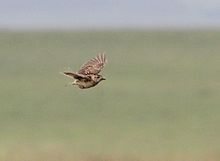| Rudd's lark | |
|---|---|

| |
| in South Africa | |
| Conservation status | |
 Endangered (IUCN 3.1) | |
| Scientific classification | |
| Domain: | Eukaryota |
| Kingdom: | Animalia |
| Phylum: | Chordata |
| Class: | Aves |
| Order: | Passeriformes |
| Family: | Alaudidae |
| Genus: | Heteromirafra |
| Species: | H. ruddi |
| Binomial name | |
| Heteromirafra ruddi (Grant, 1908) | |

| |
| distribution | |
| Synonyms | |
| |
Rudd's lark (Heteromirafra ruddi) is a species of lark in the family Alaudidae. It is endemic to South Africa. Its natural habitat is high-altitude grassland. It is threatened by habitat loss.
Taxonomy and systematics

Formerly, some authorities have classified Rudd's lark as belonging to the genus Mirafra. Previously, some authorities have also considered Archer's lark to be a subspecies of Rudd's lark (as Heteromirafra ruddi archeri). Alternate names for Rudd's lark include long-clawed lark, Rudd's long-clawed lark and South African long-clawed lark. The name "long-clawed lark" has been used to describe both Rudd's lark and Archer's lark.
Social Behavior
It is typically found alone or in pairs.
Diet
It eats insects and seeds.
References
- BirdLife International (2017). "Heteromirafra ruddi". IUCN Red List of Threatened Species. 2017: e.T22717153A118917907. doi:10.2305/IUCN.UK.2017-3.RLTS.T22717153A118917907.en. Retrieved 15 November 2021.
- Harrison, J. A., ed. (1997). The Atlas of Southern African birds: Vol.2 Passerines (PDF). Johannesburg: BirdLife South Africa. p. 26. ISBN 978-0-620-20730-0. Retrieved 4 November 2016.
- ^ "Heteromirafra ruddi - Avibase". avibase.bsc-eoc.org. Retrieved 2016-11-21.
- "Heteromirafra archeri - Avibase". avibase.bsc-eoc.org. Retrieved 2016-11-21.
- ^ Kumar, Nallapaneni Manoj; Chopra, Shauhrat S.; Rajput, Pramod (2020), "Life cycle assessment and environmental impacts of solar PV systems", Photovoltaic Solar Energy Conversion, Elsevier, pp. 391–411, retrieved 2024-02-06
External links
- Species text - The Atlas of Southern African Birds
| Taxon identifiers | |
|---|---|
| Heteromirafra ruddi |
|
This Alaudidae-related article is a stub. You can help Misplaced Pages by expanding it. |